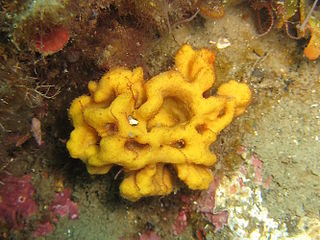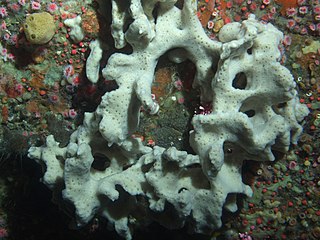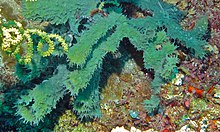
Geodia is a genus of sea sponge belonging to the family Geodiidae. It is the type genus of its taxonomic family.

Axinella is a genus of sponges in the family Axinellidae. Species of Axinella occur in the Indian and Pacific Oceans. Most of these sponges are smaller than 20 cm, and have a yellow or orange colour.
Hymeniacidon is a genus of sponges in the class Demospongiae. Some members of the genus are known to be mobile, achieving speeds of between 1 and 4 mm per day.
Stelletta is a genus of demosponge belonging to the family Ancorinidae.

Cliona is a genus of demosponges in the family Clionaidae. It contains about eighty described species.
Echinoclathria is a genus of demosponge in the family Microcionidae.
Isodictya is a genus of marine demosponge in the family Isodictyidae.
Biemna is a genus of marine demosponge in the family Biemnidae.

Haliclona is a genus of demosponges in the family Chalinidae.

Ircinia is a genus of marine demosponge in the family Irciniidae.
Darwinellidae is a family of sponges of the order Dendroceratida.
Dictyodendrillidae is a family of sponges of the order Dendroceratida.
Mycalidae is a family of marine demosponges.

Callyspongia is a genus of demosponges in the family Callyspongiidae.
Neopetrosia is a genus of marine petrosiid sponges. It was first established by the American spongiologist Max Walker de Laubenfels in 1932. It contains these 27 species:

Cinachyrella is a large genus of marine sponges from Tetillidae family.

Crella is a genus of marine demosponges in the family Crellidae.

Clathria (Clathria) is a subgenus of demosponge in the family Microcionidae.
Esperiopsis is a genus of demosponges, comprising around 30 species found in oceans around the world.
Amphilectus is a genus of demosponges, comprising around 20 species found in oceans around the world.










